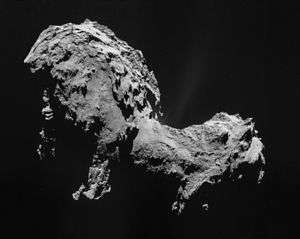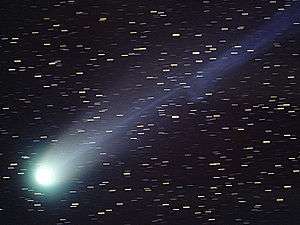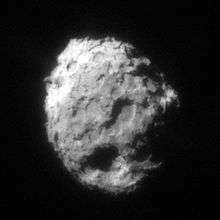List of missions to comets
As of 2013, the United States, Soviet Union, Japan and the European Space Agency have conducted missions to comets.
| Spacecraft | Launch Date[1] | Operator | Comet | Mission | Outcome | Remarks | Carrier rocket[2] |
|---|---|---|---|---|---|---|---|
| ICE (ISEE-3) |
12 August 1978 | NASA United States / ESA |
21P/Giacobini–Zinner | Flyby | 4Successful | Extended mission; Closest approach of 7,862 kilometres (4,885 mi) at 11:02 UTC on 11 September 1985. Also made distant observations of 1P/Halley in May 1986.[3] | Delta 2914 |
| Vega 1 (5VK No.901) |
15 December 1984 | Soviet Union | 1P/Halley | Flyby | 4Successful | Flew past Halley after visiting Venus; closest approach 8,889 kilometres (5,523 mi) at 07:20:06 UTC on 6 March 1986.[4] | Proton-K/D-1 |
| Vega 2 (5VK No.902) |
21 December 1984 | Soviet Union | 1P/Halley | Flyby | 4Successful | Flew past Halley after visiting Venus; closest approach at 07:20 UTC on 9 March 1986.[5] | Proton-K/D-1 |
| Sakigake (MS-T5) |
7 January 1985 | ISAS Japan |
1P/Halley | Flyby | 4Successful | Closest approach of 6.99 million kilometres (4.34 million miles) at 04:18 UTC on 11 March 1986.[6] | Mu-3S-II |
| Giotto 1 | 2 July 19851 | ESA | 1P/Halley | Flyby | 4Successful | Closest approach of 605 kilometres (376 mi) at 00:03:02 UTC on 14 March 1986.[7] | Ariane 1 |
| 2 July 19852 | ESA | 26P/Grigg–Skjellerup | Flyby | 4Successful | Extended mission. Closest approach of 200 kilometres (120 mi) at 15:30 UTC on 10 July 1992.[7] | ||
| Suisei (PLANET-A) 1 |
19 August 19851 | ISAS Japan |
1P/Halley | Flyby | 4Successful | Closest approach of 152,400 kilometres (94,700 mi) at 13:06 UTC on 8 March 1986[8] | Mu-3S-II |
| 19 August 19852 | ISAS Japan |
21P/Giacobini–Zinner | Flyby | 1Spacecraft failure (Extended mission) |
Extended mission, spacecraft ran out of fuel en route; flyby had been scheduled for 24 November 1998[8] | ||
| Deep Space 1 1 | 24 October 19981 | NASA United States |
107P/Wilson–Harrington[9] | Flyby | 1Spacecraft failure | Spacecraft was unable to reach Wilson–Harrington due to ion engine operation being suspended while a problem with the probe's star tracker was investigated.[10] | Delta II 7326 |
| 24 October 19982 | NASA United States |
19P/Borrelly | Flyby | 4Successful | Extended mission | ||
| Stardust (Discovery 4) |
7 February 1999 | NASA United States |
81P/Wild | Flyby Sample return |
4Successful | Delta II 7426 | |
| 7 February 1999 | NASA United States |
9P/Tempel | Flyby | 4Successful | Extended mission, Stardust-NExT, to survey crater caused by Deep Impact | ||
| CONTOUR (Discovery 6) |
3 July 2002 | NASA United States |
2P/Encke | Flyby | 1Spacecraft failure | Delta II 7425 | |
| 3 July 2002 | NASA United States |
73P/Schwassmann–Wachmann | Flyby | 1Spacecraft failure | |||
| 3 July 2002 | NASA United States |
6P/d'Arrest | Flyby | 1Spacecraft failure | Flyby provisionally scheduled at time of spacecraft's failure | ||
| Rosetta | 2 March 2004 | ESA | 67P/Churyumov–Gerasimenko | Orbiter | 6Operational | Entered orbit around 67P at 09:06 UTC on 6 August 2014. | Ariane 5G+ |
| Philae | 2 March 2004 | ESA / DLR Germany |
67P/Churyumov–Gerasimenko | Lander | 6Mostly successful | Carried by Rosetta. Came to rest on the surface of 67P at 17:32 UTC on 12 November 2014. Communications ceased with the loss of battery power at 00:36 UTC on 15 November 2014 and the lander began hibernating. Reactivated on solar power and briefly established contact with ground control again at 20:28 UTC on 13 June 2015, and sporadically until 9 July 2015 when the last communication was received.[11][12] | Ariane 5G+ |
| Deep Impact (Discovery 7) |
12 January 2005 | NASA United States |
9P/Tempel | Flyby/Impactor | 5Successful | Impact occurred at 05:52 UTC on 4 July 2005. | Delta II 7925 |
| 12 January 2005 | NASA United States |
103P/Hartley | Flyby | 5Successful | Extended mission (EPOXI) |
References
- ↑ McDowell, Jonathan. "Launch Log". Jonathan's Space Page. Retrieved 21 January 2013.
- ↑ Krebs, Gunter. "Interplanetary Probes". Gunter's Space Page. Retrieved 21 January 2013.
- ↑ "Solar System Exploration - ISEE-3/ICE". NASA. Retrieved 23 April 2013.
- ↑ "Solar System Exploration - Vega 1". NASA. Retrieved 23 April 2013.
- ↑ "Solar System Exploration - Vega 2". NASA. Retrieved 23 April 2013.
- ↑ "Solar System Exploration - Sakigake". NASA. Retrieved 23 April 2013.
- 1 2 "Solar System Exploration - Giotto". NASA. Retrieved 23 April 2013.
- 1 2 "Solar System Exploration - Suisei". NASA. Retrieved 23 April 2013.
- ↑ Wilson-Harrington is catalogued as both a comet and an asteroid
- ↑ "Solar System Exploration - Deep Space 1". NASA. Retrieved 23 April 2013.
- ↑ "Rosetta's lander Philae wakes up from hibernation". European Space Agency, Rosetta Blog. 14 June 2015. Retrieved 14 June 2015.
- ↑ Baldwin, Emily (20 July 2015). "Rosetta and Philae status update". European Space Agency. Retrieved 11 August 2015.
This article is issued from Wikipedia - version of the 10/4/2016. The text is available under the Creative Commons Attribution/Share Alike but additional terms may apply for the media files.



